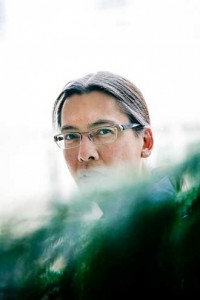
The new agriculture starts by taking the “junk” out of “junk DNA”
By Mark Shainblum
To say that Dr . Thomas Bureau has “a lab” would give you the wrong impression. Yes, there’s a classic, rather small lab in the Stewart Biology Building, full of test tubes and hi-tech microscopes and brightly coloured chemicals. There’s even an antique manual typewriter still sitting on the lab bench where it was abandoned, probably a decade or more before Bureau was born. No one uses it, but no one has the heart to dispose of it either.
This is only a temporary snapshot anyhow, as this lab will be changing and growing rapidly in the wake of a $4.5 million research prize Bureau was awarded in April by Genome Canada and Genome Quebec.
In any case, Bureau’s groundbreaking genomics work at McGill’s Department of Plant Biology isn’t centered in this lab. You’ll find the living, green heart of it in the McGill Phytotron, a closed experimental greenhouse
located on the roof of the Stewart Biology Building, and in the hulking, humming, climate controlled growing chambers a couple of floors down.
That’s where Bureau grows his samples of arabidopsis, a tiny green flowering plant you’ve seen countless times peeking through cracks in the sidewalk or cluttering up your otherwise pool-table smooth lawn.
You would probably consider the plant, also known as rock cress, to be a weed, if you thought of it at all, and you certainly wouldn’t want to eat it. But surprisingly, it belongs to the same brassica family that
includes important crop plants like canola, cauliflower, broccoli, cabbage, radishes and mustard, to name only a few. Unlike its edible cousins, however, arabidopsis has a relatively simple genetic structure and a short growing time that makes it an ideal model organism for genetic research.
Using this humble little weed, Bureau hopes to shake up the world of plant biology and change the face of Canadian agriculture in the 21st century. A tall order? Maybe. But Bureau and his colleagues are working
at the edge of known genomics, exploring part of the genome previously dismissed as mere “junk DNA.”
“The very term ‘junk DNA’ gives you this image of someone spitting on the ground,” says Bureau passionately. “It’s been completely off the radar for most genomicists and microbiologists.”
Like a few of his McGill colleagues working in human biology, Bureau is convinced that the vast, genetic no-man’s land of ‘junk DNA’ (or to be more politically correct, ‘non-coding DNA’) actually plays a vital role
in the genetic expression of an organism.
“A lot of data that’s been growing within the community seems to show that this so-called ‘junk DNA’ actually has important functions in terms of cell development and maintaining the organism. And in this case, it has agronomic importance. Those particular regions within that sea of junk DNA might be important
for agronomic traits like freezing tolerance or nitrogen use efficiency. No one’s really done a systematic survey, let alone exploit that information. So we don’t really even know what’s in that DNA. It’s a true
no-man’s land.”
Two trays of arabdopsis plants removed from a growing chamber certainly seem to bear out the importance of this previously ignored area. The control group is perfectly normal, straight and tall, if tiny. But the
experimental plants, subject to a single genetically engineered change within the non-coding DNA, are noticeably different: shorter, twisted, their flowers misshapen.
“Something is obviously happening here,” says Bureau. “Because the only change we made was to the non-coding DNA, and it clearly affects how the plant grows and looks. How is that in any way ‘junk’?”
